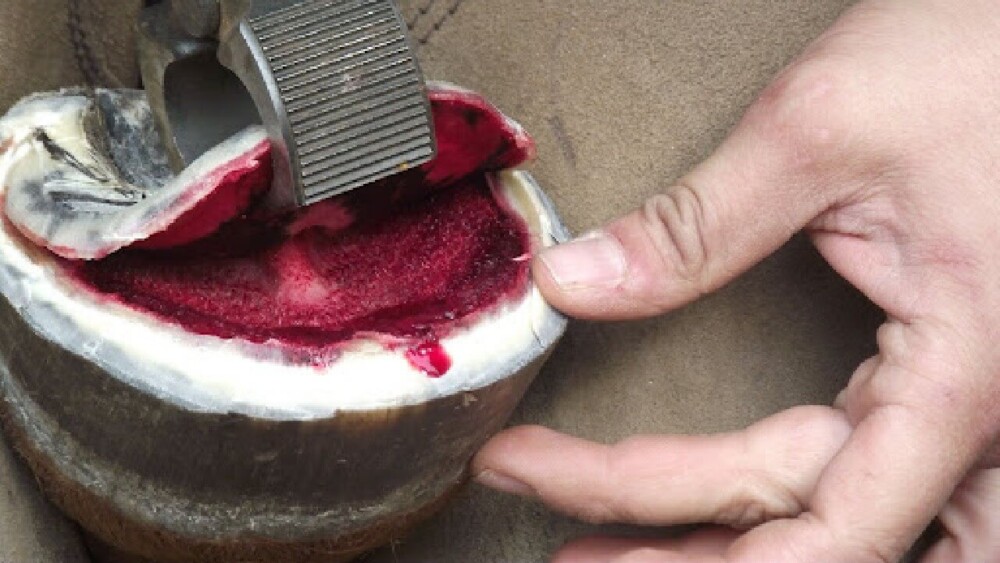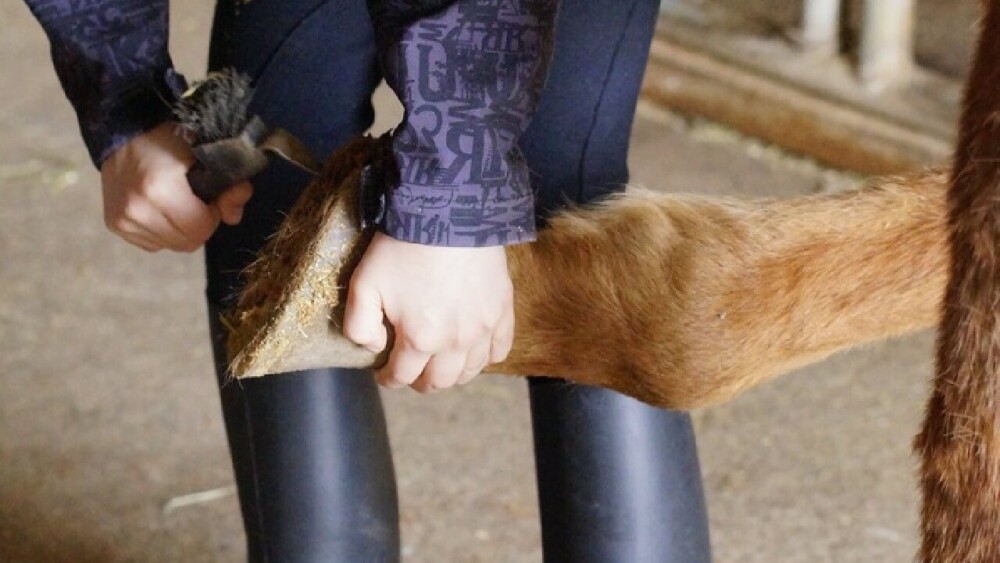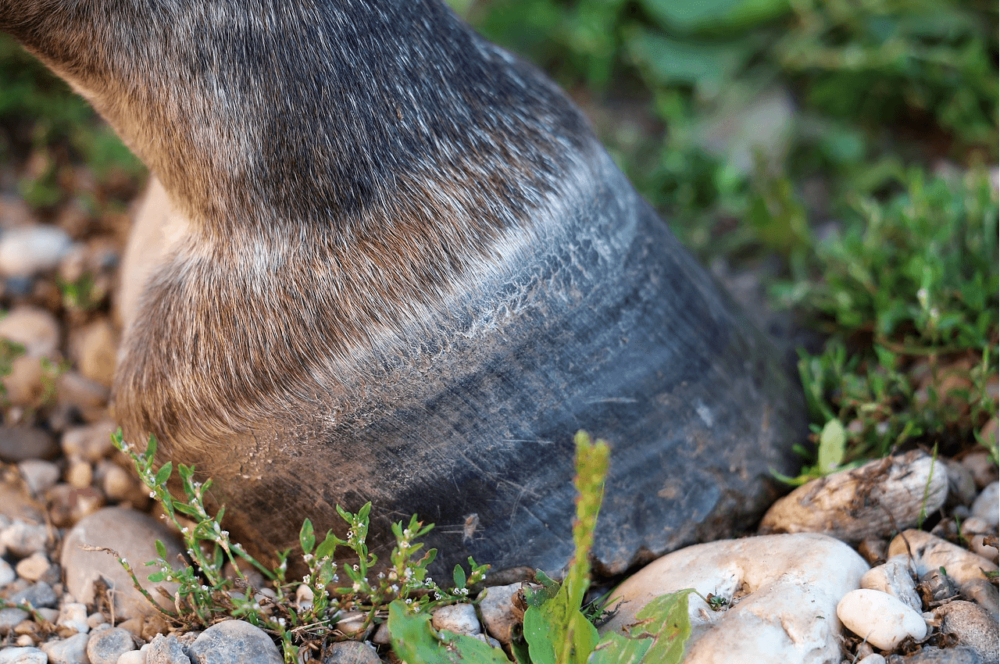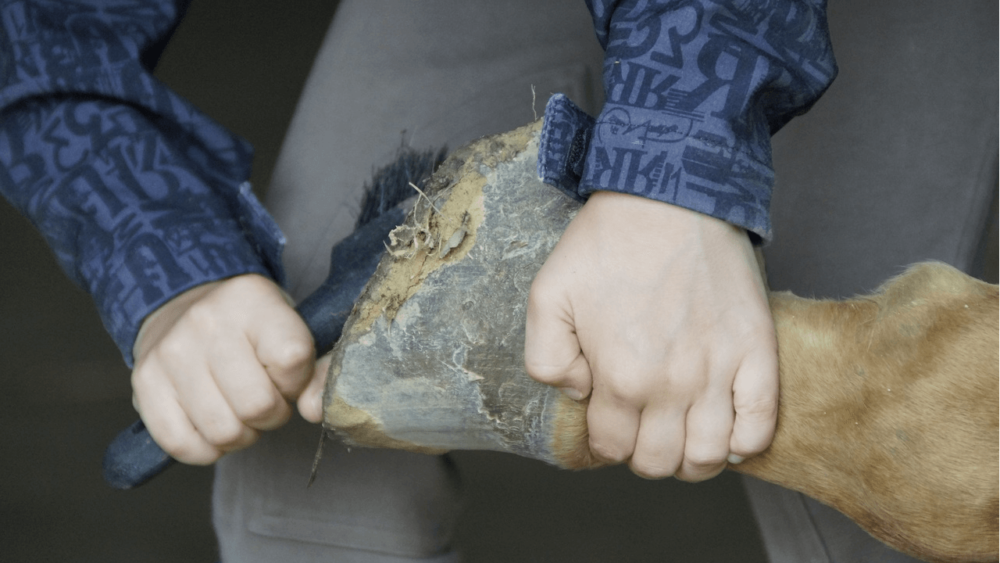This article is the second part of a 2-part series on Horse Hoof Care. To see how to prevent hoof issues, check out Part 1: Guide to Horse Hoof Care: Preventing Hoof Degloving.
When you look at a horse’s hoof, you only see the surface of a hoof. The hoof wall or capsule is the hardened covering that protects the inside of the hoof. In some instances, this covering can become damaged and expose the living tissue underneath. Known as degloving a hoof, a horse can accidentally rip off part of this capsule or all of it in extreme cases.
What is a degloved hoof? Degloving a hoof is much like ripping out a human nail, exposing the nail bed underneath. With horses, the consequences of this are much direr. Underneath the hoof capsule are several sensitive structures that are all covered with the horse’s shock-absorbing system—the laminae.
These layers of soft tissue resemble the underside of a mushroom. When your horse is moving, this tissue cushions the impact, protecting the ligaments and smaller bones inside the hoof. Severe injuries to the hoof, infections, constant compression that harden the hoof laminae, and abscesses or laminitis can cause these laminae to also harden and decay.
The last section will cover and show photos of a dissected horse’s hoof. Be aware that these images may be graphic for some readers. The horse hoof used was from a cadaver horse donated for science. No horses were harmed in the process.
Prevent Hoof Degloving When Injury Occurs
Step One: Daily Care
Make sure to follow the daily care routine described in Part 1 of this series Healthy Hoof Care. Daily inspections, cleaning, hoof picking, and leg cleaning can prevent injury. It also ensures you become aware of any hoof issues before they are serious.
Step Two: Treat All Lameness as Serious
Usually, lameness will have a muscle-related cause. However, bruises, the formation of an abscess, inflammation of the laminae (laminitis), and minor cuts and abrasions can all trigger lameness.
Until you know what has caused the issue, you should treat it as serious. Riding a horse that is slightly lame, without knowing what is causing their lameness, can result in permanent damage to the laminae. It greatly increases the chances of degloving.
Step Three: Feed Correctly
One of the main reasons for degloving is laminitis. Essentially, laminitis is an inflammatory response in the laminae of the hoof as a result of too much sugar intake. Rich green grass and molasses-based sweet feeds can lead to this condition.
This is why we see it in early spring when grass flushes, releasing more sugar. Horses grazing on this grass can have a sudden onset of laminitis. If not treated, degloving can follow when the laminae separate from the hoof capsule.
Step Four: Limit Concussion
The horse’s hoof is made to bear its weight evenly across soft earth. Running your horse on hard terrain down a dirt road or across tar roads can cause the laminae to become inflamed due to excessive compression. Then, bleeding can result.
Your farrier may advise you that there is blood in the soles of your horse’s hooves when they have their next trim, which usually indicates compression-related bleeding of the laminae.
Should your horse need to do hard work on an unforgiving surface, help prevent their feet taking a beating by shoeing them. Add special shock-absorbing pads under the shoes or encourage the growth of a longer nail with some sole removed to limit compression.
Step Five: Avoid Injuries
One of the main ways that degloving happens to a healthy hoof is due to injury. A horse may get their hoof stuck in something. The result can be a partial or a full degloving of the hoof. I’ve often seen this happen with shod horses. They get their shoe caught on something and accidentally rip off the section where the nails secure the shoe. There may be an underlying issue such as weakness or separation of the hoof wall that preceded this incident. But, sadly now you and your horse are both stuck with a problem.
Ensure paddocks are well maintained. If your horse is shod, be sure to use a trained farrier who will fit a correct size shoe. Keep your horse’s shoes clean. If you notice a shoe coming loose, book an appointment with your farrier ASAP. Loose shoes can catch on fences and wires, and the result can be a degloved hoof.
Treating a Degloved Hoof
It is possible to treat a horse that has degloved their hoof. If you can prevent sepsis or infections from setting in and stop the decaying of the exposed laminae, you may be able to help your horse stay healthy long enough for the hoof capsule (or nail) to grow from the coronary band down to the sole level. This is a LONG process, with full regrowth taking over a year, and you will need professional help.
Can a horse recover from a degloved hoof? Horses can recover from a degloved hoof, but it is a long process and requires specialized care. Degloving leaves the hoof without the protection of the outer capsule, and horses can suffer serious injury to the soft tissue inside their hoof without this capsule. Recovery time will be long, with a full degloving taking as much as a year or more for the capsule to regrow.
Consult with both your vet and your farrier about the best treatment. Usually, it involves wrapping the hoof securely to prevent any cuts or damage from an external source on the sensitive laminae.
Treatment for A Degloved Hoof
A great farrier can create a fake capsule from epoxy resin to bandage in place to help with the protection factor. Make sure the laminae doesn’t dry out. Most importantly, make sure that the hooves don’t become necrotic (and rot away).
A horse recovering from a full and even a severe partial degloving will need to be placed on a soft surface all day and night. Walking on hard ground will be exceptionally painful for them, and they will need to be fed a sugar-controlled diet to prevent or limit laminitis.
After a horse successfully regrows their hoof capsule, they are still at risk. They may have a high likelihood of laminitis, experience an increased risk of hoof distortion, or possibly be lame for the rest of their lives. For competition horses, the process and slim chance of a full recovery may lead to their owners opting for the less painful option of humane euthanizing.
Help! My Horse Has Degloved Their Hoof—What to Do
So your worst nightmare has happened, and you find your horse in the paddock or their stable with only three normal hooves and one hoof degloved. What do you do now?
- Wrap the hoof in a clean towel or bandage to keep any foreign particles or contaminants out. Don’t pull away any remaining hoof capsule sections. If the injury involves the pulling of a shoe, don’t try to remove the section of shoe that is still attached.
- Call your vet immediately, no matter the time of day. If your vet is unavailable, you can call your farrier too. Your farrier may be able to help you assess damage and help you with a pressure wrap to help prevent blood loss while you wait until your vet can come out.
- If you can, walk your horse back to a secure space where your vet can work.
- Your horse will be in tremendous pain, so you may administer an anti-inflammatory or pain medication if you have some on hand.
- Try to keep your horse still and upright.
- Watch out for pain-related colic that may set in.
- Don’t jump to the conclusion that your horse can’t possibly survive this and shoot or euthanize them.
- Wait for your vet to make an informed assessment.
Your vet will come to the best possible diagnosis based on x-rays (to assess the internal damage) and an inspection of the injury to determine its extent. If there is tendon involvement that may cause the horse’s hoof to deform completely.
The Outcome May Depend on Other Injuries
If your horse has fractured their leg while struggling during the accident, the prognosis may be poor, and euthanizing your horse may be the only option.
A horse can make a full recovery from a degloved hoof, and you should follow your vet’s prognosis. If your vet doesn’t follow a correct examination procedure by taking x-rays and assessing the blood flow to the limb, you may need to consult an equine specialist. A good vet would recommend a specialist to you if they feel they lack the knowledge or skills to help your horse. At the end of the day, the call of whether to euthanize or not is yours.
Understanding the Anatomy of A Horses Hoof (Dissection Photos Included)
I had an opportunity a few years ago to attend a hoof dissection by my excellent farrier, Marisa Anderson. At a dissection, a hoof from a cadaver horse is opened, revealing the intricate inner structures of the hoof and how these function to help the horse move. It is a most revealing and astonishing sight to look inside a hoof.



Over time, the hardening of the laminae will weaken the hold of the hoof capsule on the laminae. Then, the hoof capsule may end up losing adhesion. This can result in the degloving of the hoof. In essence, the hoof capsule separates from the laminae and comes off.
A horse can’t survive in the wild or without intense care when they have lost their hoof capsule. Special shoes, daily medical attention, and a long recovery process can help the hoof capsule grow back. Successful hoof capsule regrowth is not guaranteed though.
The best option is to look after your horse’s hooves. Ensure they are healthy and prevent any conditions that can potentially cause degloving of the hoof.
Conclusion
Your horse can survive a degloved hoof. Regrowth takes at least a year for a fully degloved hoof. It is an intensive recovery process, and you will need to be prepared for daily treatment and bandaging. Some horses make a full recovery, others don’t.
Prevent hoof degloving by keeping your horse’s hooves healthy. Check them daily for injuries and changes to their hooves. Finally, feed your horse appropriately to maintain healthy laminae. Don’t run your horse on hard ground or other surfaces that can cause compression or damage to the laminae.
If the worst happens, and your horse suffers a full or partially degloved hoof, contact your vet immediately, wrap the hoof in a towel or bandage, and give your horse something for the pain. Remain calm, as your horse will look to you for strength and reassurance.
My Favorite Equine Resources For Horses and Donkeys
This list contains affiliate products. Affiliate products do not cost more but helps to support BestFarmAnimals and our goal to provide farm animal owners with accurate and helpful information.
Squeaky Chicken Toy is hilarious to watch and the horses love it! It’s not super tough so keep it away from dogs.
Dewormer with Ivermectin: I use this for my horses and my goats. Duvet makes a great dewormer. I switch between the Ivermectin one and one like this one so the worms don’t get immune to it.
Manna Pro Apple Flavored Nuggets are a delicious smelling treat that my horses go crazy over.
Equinity Amino Acid Supplement for Horses makes a big difference for any horse that’s struggling with arthritis, hoof issues, or just generally. It’s great for older horses who can’t absorb all the nutrients in their food as well!
Manna Pro Weight Accelerator helps older horses gain weight and stay healthier! This was especially helpful when one of my older horses lost weight over the winter and helped her regain her weight over the summer!
Farnam Fly Control goes on the horse or donkey and will keep the flies off your sweet pet. It makes horses way more comfortable and will keep sores from getting infected as well.
Wound Kote protects sores and wounds. It acts as an antiseptic and helps wounds heal faster. It works on both my horses and goats.



